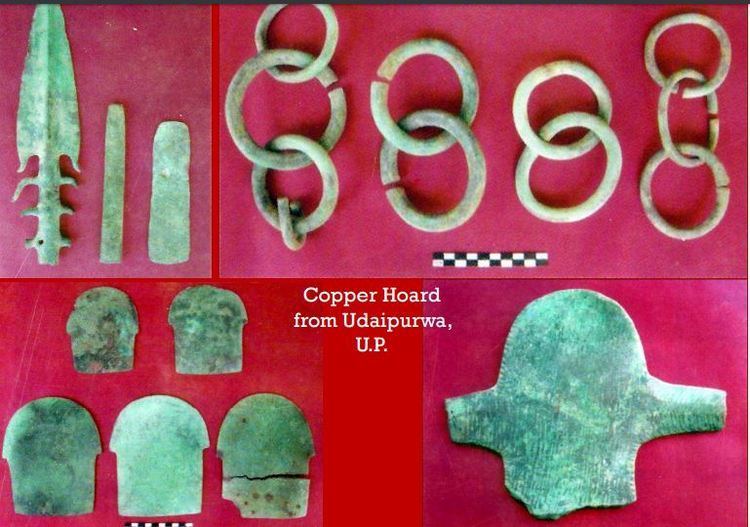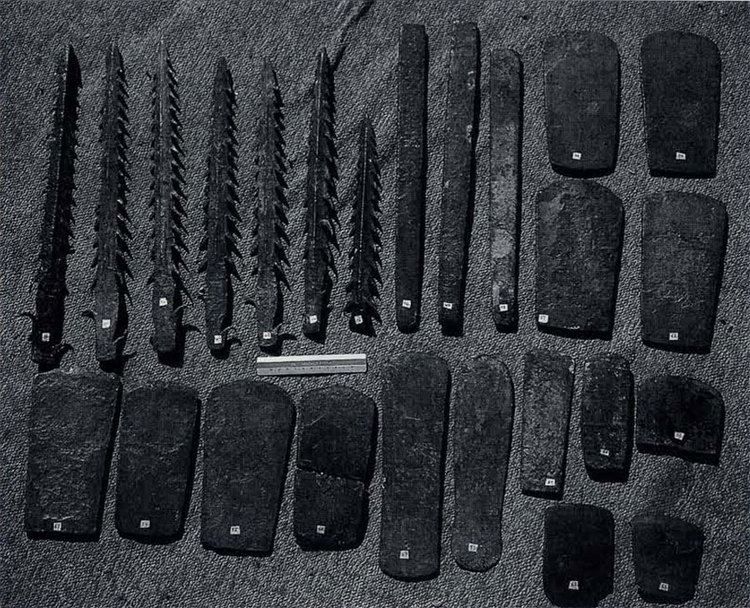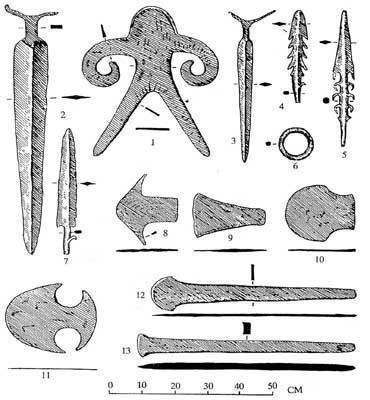 | ||
Copper Hoards describe find-complexes which occur in the northern part of India. These occur mostly in hoards large and small and are believed to date to the later 2nd millennium BCE, although very few derive from controlled and dateable excavation contexts. A fragment of an anthropomorph came to light in controlled excavations at Lothal and a second one at Saipai Lichchwai, Etawah district. The doab hoards are associated with the so-called Ochre Coloured Pottery (OCP) which appears to be closely associated with the Late Harappan (or Posturban) phase. As early as the 19th century, stray hoard objects became known and established themselves as an important find group in the two-river land of northern India. The dating is unclear. These hoard artefacts are a main manifestation of the archaeology of India during the metals age. Many are deposited in the Kanya Gurukul museum in Narela/Haryana.
Contents
- Exploration
- Regional find groups
- Characteristics of the artefacts
- Interpretations of the artefacts
- References

Exploration

The first Indian Copper Hoard harpoon was published in 1822. In a milestone publication B.B. Lal published 35 from the Gangetic basin, from the central peninsula and the eastern part of India. In 1985 Paul Alan Yule published 1083 examples from 'Copper Hoards' but also other peninsular prehistoric metal finds. These added a new group: those from southern Haryana and northern Rajasthan. By 1992 284 further examples followed specifically of the Copper Hoard types. Yule used European methods to understand the origin and meaning of the Copper hoards. For example, after deposition could the owners retrieve the finds? Moreover, each of the different constituent artefact types of a given hoard must have some meaning, but which one?
Regional find-groups

Four regional find-groups are identifiable with their characteristic find-types. Characteristic hoard finds from South Haryana/North Rajasthan (recorded: 383) include flat axes, harpoons, double axes, swords with so-called antenna grips and others. In the Ganges-Yamuna Doab (235) related types occur. Those from Chota Nagpur differ (235) entirely from these. They include finely worked pieces, and mostly look at first like axe-heads but are probably ingots. Fewer are those known from Madhya Pradesh (120), although originally there were some 424 from the Ghangaria hoard alone. Of the four find groups, the largest number derives from southern Haryana, especially from Hansi, 120 km west of Delhi Unfortunately these are purchases and are not excavated. R.A.E. Coningham believes that one of the largest hoards is that from Daimabad with 60 kg. It is an isolated contemporary phenomenon with little to do with the four main find-groups. Several writers do not distinguish between any early copper based artefacts and the more narrowly defined Copper Hoards.
Characteristics of the artefacts

Since most show no clear signs of antique use-wear, often are over-sized, or paper thin, they appear to be dedicatory and not use-implements. If those very simple ones of the Chota Nagpur group are simply ingots, the reason for the axe-like form requires explanation.

The copper ore used derives from different ore ranges in Rajasthan (Khetri), southern Haryana, Bihar/West Bengal/Orissa (especially Singhbhum) as well as Madhya Pradesh (Malanjkhand), to judge from the proximity to the find spots.

Hoard objects contain from 78-99% copper. Six contain inexplicably up to 32.9% iron. Artefacts from Haryana show the greatest chemical variation. Those from Ghangharia are chemically the most homogeneous. Variations in the amount of different constituent metals are considered to be unintentional. Harappan metallurgists seem better able to produce usable alloys.
Certain copper artefacts from the late 3rd millennium contexts in Oman resemble the anthropomorphs of the Indian Copper Hoards.
Interpretations of the artefacts
The anthropomorphs have been explained as a vajra, that is a divine weapon fashioned for the Vedic Hindu and later Hindu deity Indra. Considering the find circumstances and constituent hoard patterns, Yule found no evidence for this interpretation, or tell-tale use-wear, or traces of the wooden handle affixed to the anthropomorphs. Interpretations of the anthropomorphs as throwing weapons ignore the find circumstances of associated hoard objects, not to mention the weight (up to 7 kg) of certain examples. Form follows function.
Moreover, when in the 1st century BCE the iconography of Indra took form, the memory of Vedic weapons had since vanished. Thus the vajra of Hindu art appear to cite the keraunos of the Greek deity Zeus.
Several hoard artefacts have turned up without an archaeological context which awaken authenticity doubts. Although on their discovery frequently questioned, today few voice doubts about the four Daimabad copper finds. There is no reason and no good one to challenge the authenticity of the Haryana hoard artefacts lodged in the Kanya Gurukul in Narela. These have been expertly catalogued.
